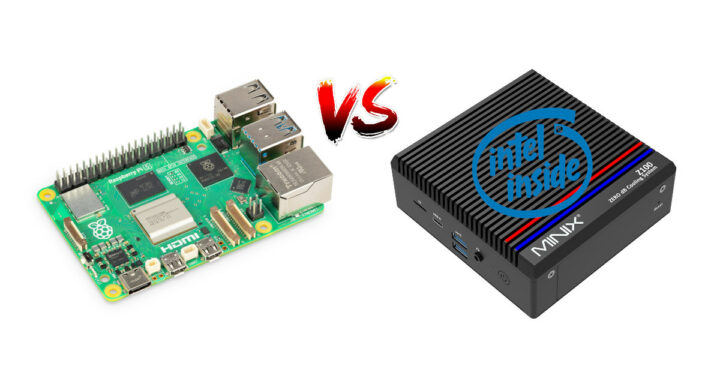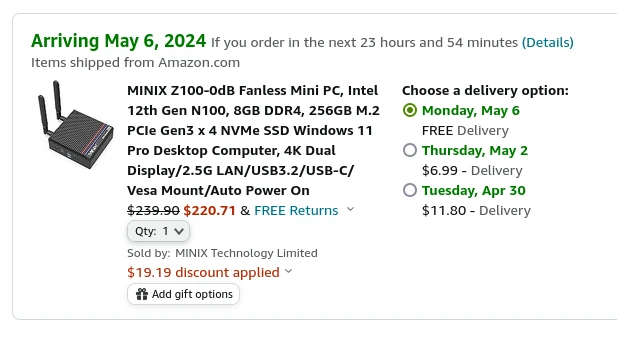The Raspberry Pi 5 Arm SBC is now powerful enough to challenge some Intel systems in terms of performance, while Intel has made the Intel Alder Lake-N family, notably the Intel Processor N100, inexpensive and efficient enough to challenge Arm systems when it comes to price, form factor, and power consumption.
So we’ll try to match the Raspberry Pi 5 to typical Intel processor N100 mini PCs with a comparison of features/specifications, performance (benchmarks), and pricing with different use cases. That’s something I’ve been wanting to look into for a while but I was busy with reviews and other obligations (Hello, Mr. Taxman!), and this weekend I had some spare time to carry on the comparison.

Raspberry Pi 5 vs Intel N100 mini PC specifications
I’ll start by comparing the specifications of a Raspberry Pi 5 against the ones for typical Intel Processor N100-based mini PCs also mentioning optional features that come at extra cost.
Raspberry Pi 5Intel N100 Mini PC
SoCBroadcom BCM2712Intel Processor N100
– CPUQuad-core Arm Cortex-A76 processor @ 2.4 GHzQuad-core “Alder Lake-N” processor @ 3.4 GHz (Turbo)
– GPUVideoCore VII GPU @ 800 MHz with support for OpenGL ES 3.1, Vulkan 1.2
24EU Intel HD graphics @ 750 MHz with support for DirectX 12.1, OpenGL 4.6, OpenCL 3.0
– Video Decode on GPU4Kp60 HEVC decoder4Kp60 AVC (H.264), HEVC (H.265), VP9, JPEG, AV1
– Video Encoder on GPUN/A4Kp30 AVC, HEVC (H.265), VP9, JPEG
System Memory4GB or 8GB LPDDR4X-4267 8GB to 32GB DDR4/DDR5/LPDDR5
StorageMicroSD card
M.2 NVMe or SATA via HAT board
2.5-inch/3.5-inch SATA drive via HAT boardMicroSD or SD card slot
Included M.2 NVMe or SATA drive
2.5-inch SATA drive slot on some systems
Video Outputs / Display Interfaces2x micro HDMI ports up to 4Kp60
2x 4-lane MIPI DSI display connectorsUp to 3 displays supported via HDMI, DisplayPort, and/or USB-C up to 4Kp60
AudioDigital audio via HDMI
Various HATs for additional audio portsDigital audio via HDMI
3.5mm audio jack (on most systems)
Camera2x 4-lane MIPI CSI camera connectors (multiplexed with MIPi DSI)Usually only through USB cameras
EthernetGigabit EthernetGigabit Ethernet, 2.5GbE, or multiple Ethernet interfaces depending on system
WirelessWiFi 5 and Bluetooth 5.0WiFi 5/6/6E and Bluetooth 4.2 to 5.4 depending on M.2 wireless module selected
USB2x USB 3.0 ports (5Gbps)
2x USB 2.0 portsDepends on system, up to 5x USB ports, with 10 Gbps USB 3.2, USB 2.0, and USB-C with DisplayPort Alt mode ports supported
GPIO40-pin Raspberry Pi GPIO headerUsually none, only available through USB to GPIO adapters
PCIeCustom connector for PCIe Gen 2 x1 (official), or PCIe Gen3 x1 (unofficial, and may not work on all boards)Standard M.2 socket with PCIe Gen3 x4
Power Supply5V/5AVaries, often 12V (30W)
Idle Power Consumption3.0 to 3.6 Watts7.5 to 10 Watts (Typ.)
Dimensions85 x 56 mmAs small as 87.8 x 87.8 x 37 mm (Blackview MP80)
Supported OSOfficial Raspberry Pi OS support
Certified Ubuntu 22.04/24.04 support
Several other OSes with various degree of supports
Usually ships with Windows 11 Pro
All x86 operating systems are supported (Linux, FreeBSD, ..) albeit full support depends on available drivers (e.g. for WiFi/Bluetooth)
Some remarks:
Intel N100 systems with DDR4/DDR5 usually rely on one (replaceable/upgradeable) SO-DIMM module while LPDDR5 is soldered on the main board. Raspberry Pi 5 always comes with soldered-on memory.
Not all USB-C ports found in Alder Lake-N mini PCs support Displayport Alt mode, it depends on the model.
Some Intel N100 SBCs such as the AAEON UP 7000 provide a GPIO header, but I wanted to focus on the features in typical mini PCs in this post. It’s also possible to add GPIO headers through a USB adapter
The Blackview MP80 mini PC is not powered by an Intel Processor N100, but by the similar Intel N95 or N97 Alder lake-N processor, and was used to show it’s possible to get a really small x86 mini PC. Most are larger than that, and the Raspberry Pi 5 should be a better option for space-constrained applications.
Benchmarks
The Raspberry Pi 5 was tested with Raspberry Pi OS Desktop 64-bit, and I selected the benchmark results for the GEEKOM Mini Air12 mini PC on Ubuntu 22.04. I haven’t run Geekbench 6 on my Raspberry Pi 5, so I took one of the results from the Geekbench 6 database for a Raspberry Pi 5 at stock (2.4 GHz) frequency. The storage read speed for the Raspberry Pi 5 was measured with a 128GB MAKERDISK NVMe SSD and the PCIe interface configured as PCIe Gen3 x1.
Raspberry Pi 5GEEKOM Mini Air12
SBC-Bench.sh
– memcpy5158.3 MB/s10459.3 MB/s
– memset11671.4 MB/s10665.4 MB/s
– 7-zip (average)10930 MIPS13940 MIPS
– 7-zip (top result)10980 MIPS13976 MIPS
– OpenSSL AES-256 16K1,367,736.32k1,233,283.75k
Geekbench 6 Single7891,213
Geekbench 6 Multi1,5233,272
Speedometer (Firefox)56.6 runs/minute149 runs/minutes
Speedometer (Chrome)63.5 runs/minuteN/A
Max storage read speed (NVMe SSD)855MB/s3.2GB/s
The Raspberry Pi 5 can be overclocked to get more performance, and some people managed to achieve 1,033 points (single-core) and 2146 points (multi-core) at 3.10 GHz, but it is still lower than on Intel Processor N100 mini PC, and may not work on all Raspberry Pi 5 boards.
The Intel N100-powered GEEKOM Mini Air12 is faster for most tasks, and in some cases up to almost three times as fast (Speedometer 2.0 in Firefox), except for memset (similar results) and OpenSSL AES-256 where the higher sustained single-core CPU frequency helps the Arm SBC.
Raspberry Pi 5 vs Intel N100 mini PC price comparison
This one will be tough as everybody has different requirements, local or import taxes, and so on. But I’ll first calculate the price of a minimum working system and the Raspberry Pi 5 equivalent of the MINIX Z100-0dB mini PC with 8GB RAM, a 256GB NVMe SSD, 2.5GbE, WiFi 6, and a fanless enclosure.
For the minimum working configuration, we’ll assume the user wants a Linux or Windows system that boots to the OS, and connects to the network and a display without any other specific requirements. The Raspberry Pi 5 4GB is good enough for this along with the active cooler, a 5V/5A power adapter (although 5V/3A might do too), and a microSD card. I also searched for the cheapest N100 mini PC I could find with storage and memory: the CHUWI Larkbox X (12GB RAM, 512GB SATA SSD) sold for $125.93 with free shipping on Aliexpress at the time of writing.
I tried to select low-cost items for the Raspberry Pi 5 and considered adding an enclosure unnecessary for the minimum configuration (it would add $5 to $20). Taxes and handling fees are not considered for either device, and the shipping fee is not included for the Raspberry Pi 5 kit which ends up being about $33 cheaper. The Larkbox X mini PC delivers higher performance and offers more memory, dual Gigabit Ethernet, and WiFi 6. The Raspberry Pi 5 remains the ideal candidate for use cases requiring GPIO, low power consumption, and a small size.
Now let’s switch to another user who will wonder “What year is this?!” when hearing or reading the words “gigabit Ethernet”, “WiFi 5”, “4GB RAM”, and/or “microSD card”. He won’t allow any noisy fan to pollute his room either, and he’d been fine with a fanless mini PC like the MINIX Z100-0dB with 8GB RAM that’s currently sold for $220.71 on Amazon excluding taxes with an 8% discount coupon selectable before order.

Let’s see what happens if we try to reproduce this setup with a Raspberry Pi 5 8GB. We’ll still need the 5V/5A power adapter and a micro HDMI cable, but we’ll replace the active cooler with a fanless metal case that can still take HAT expansion boards and the microSD card with an NVMe SSD with an M.2 PCIe Hat. We’ll need a WiFi 6 USB 3.0 dongle and a 2.5GbE USB 3.0 dongle, although HAT expansion boards could be daisy-chained to achieve the same result, but that would start to get messy and be more expensive.
The Raspberry Pi 5 system is still cheaper (by $20) before taking into account the shipping fees which may add up when purchasing from multiple vendors. The EDATEC fanless case is also hard to get as it’s not for sale on Aliexpress anymore, and finding another complete Raspberry Pi 5 case that takes a HAT+ expansion board is challenging. We’ve also created a monster with a HAT and all four USB ports would be used in a typical system with a USB keyboard, a USB mouse, and our two USB 3.0 dongles for WiFi 6 and 2.5GbE. In that specific use case, I’d consider the Raspberry Pi 5 to be undesirable, and people would be better served by a mini PC. I reckon I’ve pushed the requirements a bit far with WiFi 6 and 2.5GbE, as I’d expect many people would be fine the the built-in gigabit Ethernet and WiFi 5 connectivity, in which case the Pi 5 could still be considered.
Final words
As one would expect, there’s no simple answer to the question “Which is the best? A Raspberry Pi 5 SBC or an Intel N100 mini PC?” since it will depend on the user’s specific requirements. The Raspberry Pi SBC was first introduced as cheap hardware for the education market, and I would recommend the Raspberry Pi 4 over the Raspberry Pi 5 for this purpose since it’s cheaper and does the job. The Raspberry Pi 5 is more suitable for projects that require extra performance while keeping the small form factor, GPIO header, and camera connectors. Intel Processor N100 mini PCs offer a better performance/price ratio as a general-purpose computer running Windows 11 or a Linux distribution such as Ubuntu, although you may potentially save a few dollars by using a Raspberry Pi 5.

Jean-Luc started CNX Software in 2010 as a part-time endeavor, before quitting his job as a software engineering manager, and starting to write daily news, and reviews full time later in 2011.
Support CNX Software! Donate via cryptocurrencies, become a Patron on Patreon, or purchase goods on Amazon or Aliexpress
>>> Read full article>>>
Copyright for syndicated content belongs to the linked Source : Hacker News – https://www.cnx-software.com/2024/04/29/raspberry-pi-5-intel-n100-mini-pc-comparison-features-benchmarks-price/































